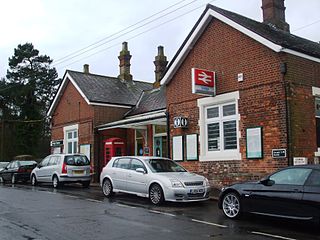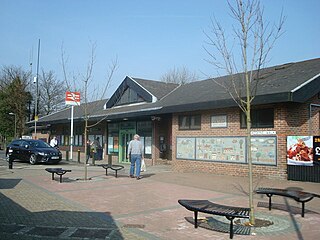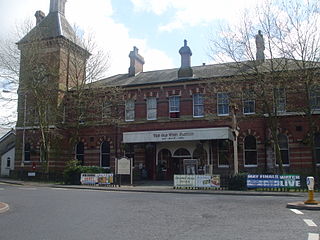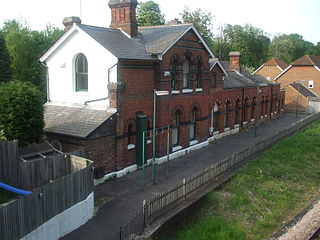
The Bluebell Railway is an 11 mi (17.7 km) heritage line in West Sussex in England. It is managed by the Bluebell Railway Preservation Society. It uses steam trains which operate between Sheffield Park and East Grinstead, with intermediate stations at Horsted Keynes and Kingscote.

The London, Brighton and South Coast Railway was a railway company in the United Kingdom from 1846 to 1922. Its territory formed a rough triangle, with London at its apex, practically the whole coastline of Sussex as its base, and a large part of Surrey. It was bounded on its western side by the London and South Western Railway (L&SWR), which provided an alternative route to Portsmouth. On its eastern side the LB&SCR was bounded by the South Eastern Railway (SER)—later one component of the South Eastern and Chatham Railway (SE&CR)—which provided an alternative route to Bexhill, St Leonards-on-Sea, and Hastings. The LB&SCR had the most direct routes from London to the south coast seaside resorts of Brighton, Eastbourne, Worthing, Littlehampton and Bognor Regis, and to the ports of Newhaven and Shoreham-by-Sea. It served the inland towns and cities of Chichester, Horsham, East Grinstead and Lewes, and jointly served Croydon, Tunbridge Wells, Dorking and Guildford. At the London end was a complicated suburban and outer-suburban network of lines emanating from London Bridge and Victoria, and shared interests in two cross-London lines.

East Croydon is a railway station and tram stop in Croydon, Greater London, England, and is located in Travelcard Zone 5. At 10 miles 28 chains from London Bridge, it is the 20th busiest station in Britain, was the 10th busiest in 2020–21, is the busiest national rail station in London outside of fare zones 1 and 2 and is one of the busiest non-terminal stations in the country. It is one of three railway stations in the London Borough of Croydon with Croydon in their name, the others being West Croydon and South Croydon. A Tramlink tram stop is located immediately outside the main station entrance.

The Spa Valley Railway (SVR) is a standard gauge heritage railway in England that runs from Tunbridge Wells West railway station in Tunbridge Wells to High Rocks, Groombridge, and Eridge, where it links with the Oxted Line.

The Lavender Line is a heritage railway based at Isfield Station, near Uckfield in East Sussex, England.

The East Coastway line is a railway line along the south coast of Sussex to the east of Brighton, England. Trains to the west of Brighton operate on the West Coastway line. Together with the West Coastway and the Marshlink line to the east, the line forms part of a continuous route from Havant to Ashford. The Brighton Main Line route to Eastbourne and Hastings, via Plumpton and Cooksbridge, shares the East Coastway line east of Lewes station.

The Woodside and South Croydon Joint Railway (W&SC) was a short, relatively short-lived and unsuccessful railway in the London Borough of Croydon in London, England. Its site is now largely occupied by Tramlink.

Uckfield railway station is the southern terminus of a branch of the Oxted Line in England, serving the town of Uckfield, East Sussex. It is 46 miles 8 chains (74.2 km) from London Bridge.

Eridge railway station is on the Uckfield branch of the Oxted line in southern England and serves a rural district around Eridge in East Sussex. It is 35 miles 53 chains from London Bridge. The station is managed by Southern.

Hurst Green railway station is on the Oxted line in southern England and serves the Hurst Green neighbourhood of Oxted in Surrey. It is 21 miles 20 chains from London Bridge. The station is managed by Southern.

Oxted railway station is on the Oxted line in southern England, serving the commuter town of Oxted, Surrey. It is 20 miles 25 chains from London Bridge. The station is managed by Southern who operate the majority of train services with a few peak services operated by Thameslink.

East Grinstead railway station is one of the two southern termini of the Oxted line in the south of England and serves East Grinstead in West Sussex. It is 30 miles 4 chains from London Bridge, although trains mostly run to and from London Victoria. The station is managed by Southern.

Tunbridge Wells West is a railway station located in Royal Tunbridge Wells, Kent, England. It is one of two railway stations in Tunbridge Wells constructed by rival companies. The other, Tunbridge Wells Central was opened in 1845 by the South Eastern Railway (SER). Tunbridge Wells West was closed to mainline passenger services in 1985. A new station on part of the site has been opened as a heritage railway line opened in 1996. It stands next to the original engine shed which has been restored to use. The line is called the Spa Valley Railway.

Groombridge railway station is a station on the Spa Valley Railway (SVR) in Groombridge, East Sussex, England. Once a busy station serving four directions, it closed in 1985 to British Rail services. A new station the other side of Station Road bridge was opened by the SVR in 1997 as part of a standard gauge heritage railway to Tunbridge Wells West.
The Cuckoo Line is an informal name for the now defunct railway service which linked Polegate and Eridge in East Sussex, England, from 1880 to 1968. It was nicknamed the Cuckoo Line by drivers, from a tradition observed at the annual fair at Heathfield, a station on the route. At the fair, which was held each April, a lady would release a cuckoo from a basket, it being supposedly the 'first cuckoo of spring'. The railway line served the following Sussex communities: Polegate, Hailsham, Hellingly, Horam for Waldron, Heathfield, Mayfield, Rotherfield and Eridge. Services continued through Eridge and onward via Groombridge to Tunbridge Wells.
The Three Bridges–Tunbridge Wells line is a mostly disused railway line running from Three Bridges in West Sussex to Tunbridge Wells Central in Kent via East Grinstead in West Sussex, a distance of 20 miles 74 chains (33.7 km). Opened in 1855, the main section of the line was a casualty of the Beeching Axe – the last train ran on 1 January 1967. The remaining section to Tunbridge Wells closed on 6 July 1985, although the section between Groombridge and Tunbridge Wells West was reopened in 1997 under the auspices of the Spa Valley Railway.
The Wealden Line is a partly abandoned double track railway line in East Sussex and Kent that connected Lewes with Tunbridge Wells, a distance of 25.25 miles (40.64 km). The line takes its name from the Weald, the hilly landscape the lies between the North and South Downs.
The Surrey and Sussex Junction Railway (SSJR) was an abortive railway scheme to link Croydon to Tunbridge Wells, via Oxted. The company obtained powers to build the line, with the intention that it would be worked by the London Brighton and South Coast Railway (LBSCR). The project was abandoned, before completion, in 1867. Part of the trackbed was later used in the construction of the Oxted line.
Frederick Dale Banister MICE, was an English civil engineer, best known for his 35 years as the Chief Engineer of the London, Brighton and South Coast Railway (LB&SCR).
Thomas Harrison Myres FRIBA was an English railway architect who designed stations and ancillary buildings for the London, Brighton & South Coast Railway lines that were opened between 1880 and 1883, including several on what is now the Bluebell Railway. He was the son-in-law of the railway company's chief engineer, Frederick Banister. Although most of the lines for which Myres designed the buildings have been closed, many of his buildings survive as private residences. Several of the buildings designed by him are listed buildings, including the goods shed at Singleton in West Sussex which was declared Grade II in April 2013.



















